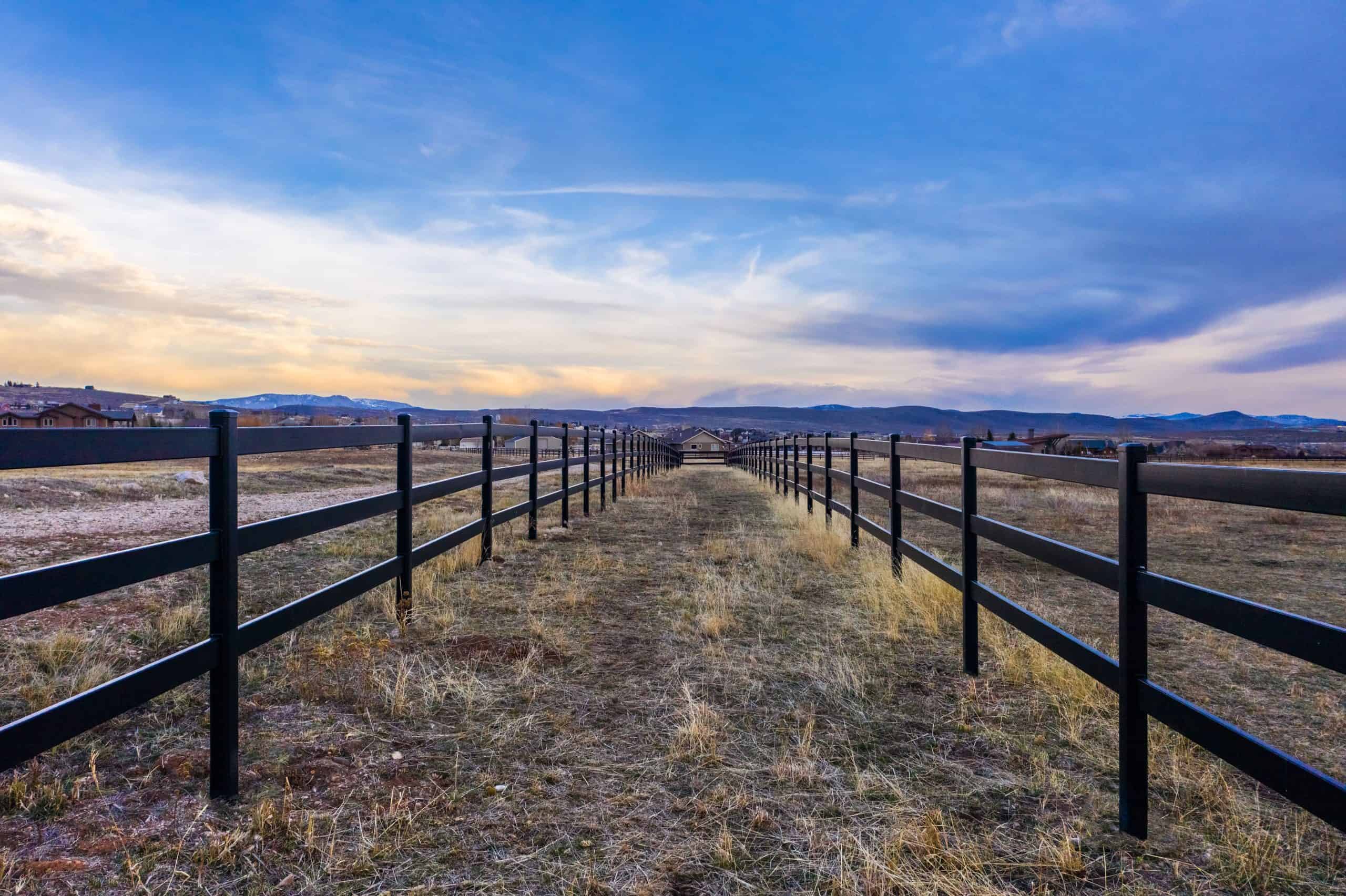Every ranch is different. Different animals, different terrain, different priorities. But one thing stays the same…you need fencing that contains your livestock without breaking the bank or demanding constant maintenance.
The fencing that works for cattle might injure horses. What contains sheep won’t hold goats. And mixed operations face the challenge of satisfying multiple species’ needs with a single system. There’s no universal solution, but there are smart approaches that work consistently across different situations.
We’ve watched ranchers try every fencing idea imaginable. Some work beautifully. Others fail expensively. Below, we’re sharing the livestock fencing ideas that actually perform in real ranch conditions.
Understanding Different Livestock Needs
Before exploring specific fencing ideas, understand what you’re containing.
- Cattle: Generally respect visible boundaries once trained. Need strength more than height. Will lean heavily on fencing and push through weak sections when motivated by better grass. Standard height is 48-52 inches with posts every 8-12 feet depending on terrain.
- Horses: Require smooth surfaces to prevent injury. Test boundaries constantly, especially young stock. Need excellent visibility. They respect what they can see clearly. Prone to panic reactions that can destroy inadequate fencing. Our safe fencing for horses guide covers these specific requirements in detail.
- Sheep: Low center of gravity means they can slip under fencing cattle can’t. Need tight spacing at ground level. Will follow each other through any gap one discovers. Pressure-treated wood posts resist their habit of rubbing against fencing.
- Goats: The ultimate escape artists. Will climb, jump, squeeze through, and work at weak points until finding a way out. Require tight wire spacing and often need electrification for psychological deterrent. Standard fencing height of 4-5 feet often proves inadequate for determined goats.
- Mixed Operations: Must satisfy your most demanding species. Usually means horse-safe design with cattle-appropriate strength and tight spacing for smaller stock. Costs more initially but prevents the headaches of multiple fence types.
Traditional Board Fencing for Livestock
The classic rail fence approach provides excellent visibility and proven containment. Whether you’re considering 3 vs 4 rail fencing configurations, board systems create psychological and physical barriers that livestock respect.
- Wood Rail Fencing: Traditional split rail or board fencing delivers that classic ranch aesthetic. Works well for horses and cattle that respect boundaries. Requires significant maintenance: painting, board replacement, and rot prevention. Expect 10-15 year lifespan with consistent upkeep. For rustic fence ideas that maintain that traditional look, explore naturally weathering wood options.
- Steel Board Fencing: Takes the proven rail fence design and eliminates wood’s maintenance headaches. Our steel board system provides the same visual impact with 30+ year lifespan and minimal maintenance. The smooth surfaces prevent injury to horses while providing strength cattle can’t push through. Works exceptionally well for mixed operations containing both species.
- Vinyl Rail Fencing: Lower maintenance than wood but becomes brittle over time, especially in temperature extremes. Works adequately for decorative paddocks but struggles with heavy livestock pressure. Our vinyl fence comparison explains why many ranchers eventually replace vinyl with more durable alternatives.
For horse paddock fencing specifically, rail systems excel because they provide clear visual boundaries while allowing airflow and visibility between paddocks.
Wire-Based Livestock Fencing Solutions
Wire fencing offers economical coverage for large acreage, though it comes with trade-offs.
- High-Tensile Smooth Wire: Efficient for containing cattle across large pastures. Requires proper tensioning and regular maintenance. Not suitable as primary horse fencing due to injury risk, though some ranchers use it successfully with electric deterrent added. Learn more about high tensile fence for horses and its limitations.
- Woven Wire (Field Fence): Popular for sheep and goats due to tight spacing. Provides good physical barrier but sags over time under livestock pressure. We’ve detailed the specific issues in our field fence for horses article (primarily entanglement risks and durability concerns).
- No-Climb Wire Mesh: Combines the coverage of woven wire with tighter spacing that prevents hooves from penetrating. Excellent choice for horses when paired with quality top rail. Our no-climb horse fencing guide explains proper installation for maximum safety and longevity.
- Electric Wire: Psychological deterrent more than physical barrier. Works well as a supplement to other fencing types. Requires consistent voltage maintenance and won’t contain panicked animals. Our electric fence for horses resource covers when this option makes sense and when it doesn’t.
Pipe Fencing for Heavy-Duty Applications
Pipe fence systems provide maximum strength for challenging livestock situations.
- Welded Pipe Panels: Strongest option for high-pressure areas like working pens and bull containments. Essentially indestructible under normal livestock pressure. The welded construction eliminates weak points that livestock might exploit. However, welded connections create rust vulnerabilities over time that require monitoring.
- Continuous Rail Pipe: Similar strength to welded systems but with flexible connections that absorb impact better.
This fencing costs more initially but lasts decades in applications where other materials fail quickly. Working pens, bull enclosures, and high-traffic areas justify this investment.
Specialized Fencing Applications
Some situations demand purpose-built solutions beyond standard perimeter fencing.
- Arena Fencing: Training and exercise areas need specific design considerations. Our horse arena fencing guide covers sight line requirements, appropriate heights, and impact resistance needed for these high-use spaces.
- Round Pens: Training facilities require circular construction with consistent sight lines. Standard rectangular fencing won’t work. You need materials that accommodate curves without compromising strength.
- Temporary Fencing: Rotational grazing and seasonal needs require portable solutions.
- Predator Protection: If containing livestock isn’t enough, consider coyote-proof fence strategies that combine proper fencing with ground barriers and height considerations.
Color and Aesthetic Considerations
Functionality matters most, but appearance impacts property value and daily satisfaction.
- White Fencing: Classic choice that provides maximum visibility for livestock. Shows dirt quickly but creates that iconic ranch aesthetic many prefer. Powder-coated white on steel maintains appearance far longer than painted wood.
- Black Fencing: Increasingly popular for modern ranch aesthetics. Our black fencing provides dramatic visual impact while hiding dirt and wear better than white. Works especially well on properties with darker-colored livestock or contemporary architecture.
- Natural/Earth Tones: Blends with landscape for less visual impact. Works well where covenants restrict traditional white fencing or owners prefer understated boundaries.
Gates and Access Points
Even perfect fencing fails if gates don’t match quality and functionality. Our horse gates are engineered to match fence line strength while providing smooth operation that doesn’t sag over time. The same design principles that make our fencing durable apply to our gate systems: heavy-gauge materials, corrosion-resistant coatings, and engineering that considers livestock pressure.
- Latch Selection: Horse-proof latches prevent escapes from clever animals while remaining easy for humans to operate. Our fence latches include the EZ Latch system designed specifically for livestock operations. It’s operable from horseback, animal-proof when engaged, and built to last decades without maintenance.
- Gate Sizing: Refer to our gate dimensions guide for proper opening sizes that accommodate equipment while maintaining security. For properties requiring wide access, review our double gate specifications for installations that maintain fence line integrity.
Additional Resources for Livestock Fencing
Take a look at our comprehensive guides for deeper dives into specific topics:
- Ranch fencing overview covering large-acreage considerations
- Farm fence ideas for smaller agricultural operations
- Farm and pasture fencing ideas for grazing management
- Best types of metal fences comparing steel, aluminum, and pipe options
- FAQ section answering common livestock fencing questions
Build It Right the First Time
Livestock fencing is a major investment in your operation’s future. The decisions you make now determine whether you’re maintaining safe, functional boundaries decades from now or replacing failed fencing every few years.
We’ve built our reputation on providing products that work for real ranches containing real livestock. Our steel board fencing delivers the proven rail fence aesthetic with durability that wood can’t match and maintenance requirements far below vinyl alternatives.
Whether you’re fencing cattle, horses, or mixed livestock operations, we’ve got the experience and products to help you build it right. Review our complete product line or contact us to discuss your specific livestock fencing needs.
Your animals deserve secure containment. Your operation deserves fencing that works long-term. And you deserve to spend weekends enjoying your livestock, not fixing fence. Let’s make that happen.
Frequently Asked Questions
Q. What’s the most versatile fencing for mixed livestock operations?
Steel board rail fencing with optional wire mesh addition provides horse-safe smooth surfaces, cattle-appropriate strength, and tight spacing for smaller stock when needed. This combination handles multiple species without compromising safety for any of them.
Q. How much does quality livestock fencing cost per linear foot?
Expect $15-25 per foot for wire-based systems, $20-30 for quality wood rail, and $29-36 for steel board fencing including installation. While steel costs more initially, its 30+ year lifespan with minimal maintenance makes it the most economical long-term choice for most operations.
Q. Can I install livestock fencing myself or should I hire professionals?
Straightforward fence lines on level terrain suit DIY installation for experienced ranchers. Complex layouts, difficult terrain, or large projects often benefit from professional installation that ensures proper post depth, alignment, and tensioning. Poor installation compromises even quality materials.
Q. What fence height works for different livestock types?
- Cattle: 48-52 inches.
- Horses: 54-60 inches depending on breed.
- Sheep: 40-48 inches.
- Goats: 48-60 inches (and they’ll still test it)
Mixed operations should match requirements of your most demanding species to prevent containment failures.
Q. How do I prevent livestock from damaging new fencing?
Allow concrete to cure fully (3-7 days) before introducing livestock. Train animals to respect boundaries by supervising initial turnout. Provide adequate space, water, and forage so livestock aren’t motivated to push through for resources. Strategic placement of feeding areas away from fence lines reduces pressure on boundaries.



